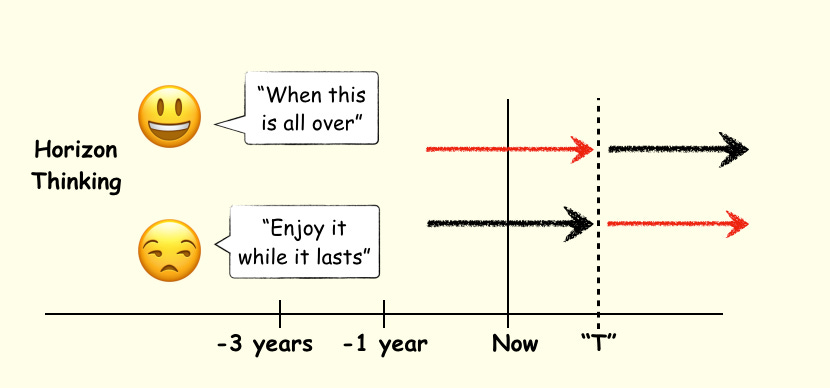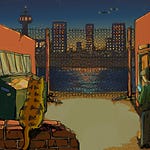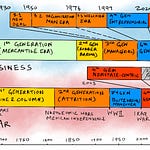Hello and welcome back to the Breaking Smart podcast. In this episode, I want to pick up where I left off in my December 6 podcast, where we talked about the idea of inventing time. In particular, we talked about how to understand Alan Kay’s line that it’s easier to invent the future than to predict it, and William Gibson’s line that the future is already here, it’s just unevenly distributed. We talked about how to develop your instincts around recognizing when you’re living in a growing timeline versus a dying one.
In this episode, I want to build on that, and talk about how to navigate better in time by going beyond optimism vs. pessimism frames.

Here’s my definition of normalcy: things are normal when it’s easy to guess whether you’re living in a growing or a dying timeline. This doesn’t mean your guess is correct. It’s just means it is easy to guess. The options and their narrative meanings are unambiguous.
How do you know you’re in this condition?
You know by the fact that a particular anticipated event in the future acquires a particular significance, and you use the narrative meaning of that event to judge the good and bad things in the present. Let’s call it the Arrival Event.
For example, in 2012, two such arrival events framing the future for the United States were “software is eating the world” and “immigrants are taking over the country.” Both had implied events when the processes could be considered irreversibly complete. You could navigate around the progress of that process. It would have been your clock in 2012. Countdown timers to T=0.
The Arrival Event usually isn’t a real event. It just has to represent a significant irreversible phase transition hypothesis about history. An undeniable arrival into a new condition. In fact, the event is usually beyond the horizon in the distant future, so you’re always moving towards a horizon that’s moving away from you. But on the other hand, don’t make the mistake of thinking that the Arrival Event is necessarily an imagined arrival into a pure utopia or dystopia. It can be more more real than that. So the Arrival Event you’re orienting around during normal times is somewhere between real and imaginary.
This semi-mythical Arrival Event is the temporal equivalent of a True North. A meaningful but beyond-the-horizon point in time that you can orient around. Just as you often head north, but rarely actually have the magnetic north pole within your spatial horizon, you’re always counting down towards your arrival event in time, but it’s rarely within any actual practical temporal horizon.
Now here’s my claim: the sense of a significant arrival event beyond the horizon is at the root of both optimistic and pessimistic attitudes towards the present. Both are patterns of horizon thinking. Both lead you to interpret current events, which are always a mix of good and bad, in specific ways. Misfortunes seem less burdensome if you sense good times are around the corner, and on the other hand, fortunate events seem less valuable if you feel it is all about to get destroyed anyway soon.
By definition, optimists tend to be cheerful about troubles in the present, and declare that better times are just beyond the horizon: “when this is all over….” X, Y, and Z will happen and things will be better.
Pessimists on the other hand, tend to be gloomy about positive things about the present and declare that the apocalypse is just around the corner: “enjoy it while it lasts….” because X, Y, and Z will happen and then it’ll an apocalyptic disaster.
The thing is, they are both right. Each is living in a particular fork of the unevenly distributed future being invented in the present. The optimist is choosing to live in what they think is the growing, generative part of the unevenly distributed future, while the pessimist is choosing to live in what they think is the dying, degenerating part. One is fighting to accelerate their Arrival Event, the other is fighting to delay theirs.
Importantly, both are just guesses. If in 2012, you thought that the growing future was happening in San Francisco and the dying past was in Pittsburgh, that was a guess about the relative significance of good and bad things going on in both places, in relation to your true north Arrival Event, and you made a choice based on that guess.
The thing about normalcy is that you can in fact make such a choice, because so long as the Arrival Event is in the far future, the estimated growing and dying parts tend to be clearly separated in narrative space, and moving from one to another can be as simple as moving from Pittsburgh to San Francisco. From a city you think is living in the dying past to a city you think is living in the growing future.
Or to put it another way, normalcy is when you can reduce the flow of time to a sequence of two arrows. There’s the past pointing to the significant future event T, and the post-arrival future starting at T, creating a new world. In this scheme, the present Now is not that important because you’re not oriented around it.
You can have the luxury of such a simple mental model because you’re choosing to live in a clearly separated narrative timeline: either an optimistic one or a pessimistic one. The only difference is which of the two arrows represents good times and which one represents bad times.
Now the interesting question is, what happens when you can’t separate the two that easily? What if the future is not just unevenly distributed in the present, but illegibly distributed, so you can’t easily put yourself in the middle of a purely optimistic or pessimistic narrative. This is that schizophrenic sense of being the best of times and the worst of times at once. This is the sense of being inside what I’ve been calling The Great Weirding.
One way to understand the collapse of normalcy is that you have actually arrived at the significant future event T that you were anticipating in normal times.
So T=Now. The countdown timer has counted down to zero.
It is the temporal equivalent of the phenomenon of the compass becoming useless when you are actually standing on top of true magnetic north. It’s right under your feet, so the compass can’t tell you which way to head. It’s a division or multiplication by zero.
So why and how can this happen? Because arrival events are not actually mythical events that are always beyond the horizon. Sometimes they cross over the horizon and get closer and closer, and more and more real, till we’re actually living right through them.
When that happens, the approximate separation of growing and dying futures breaks down. The estimates of whether you were living in good or bad parts of the unevenly distributed future have an encounter with ground reality. And the futures you were betting on have an IPO, so to speak.
And you have to scramble to correct your position.
What’s worse, because you have arrived, you no longer have a future arrival event as a reference measure to gauge the significance of current events, good or bad. You have no way to judge what anything means. You’ve lost your sense of proportion because you’ve lost the thing that gave you that sense of proportion. You don’t know what things in the now mean, because you can’t value them in proportion to where you’re going next.
That’s the condition of the Great Weirding. And next time, I’ll talk about how to orient when you’re in an arrival condition with a useless compass.












Beyond Optimism and Pessimism